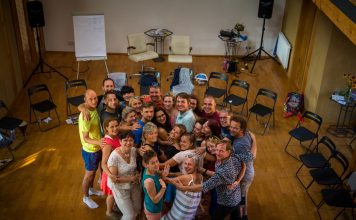Baselworld 2004: TAG Heuer took the watchmaking world by surprise when it launched a revolutionary concept-watch. The mechanical Monaco V4 overturned basic watchmaking principles by featuring driving belts and ball-bearings instead of the conventional wheels and pinions. Representing a daring move undertaken with the help of watchmaker Philippe Dufour, the Monaco V4 sprung a surprise, aroused admiration and raised immediate debate and questions. Opinions were divided: was it a real watchmaking breakthrough or just a marketing gimmick? The concept watch certainly left nobody indifferent.
After 36 months and thousands of hours of design, simulation and finally construction, TAG Heuer returns to Baselworld 2007. This time with not only a prototype that has turned out a remarkable performance over a year, confirming that toothed belts can be used instead of wheels and pinions, but also with some pre-series products that give an idea of the movement’s final construction. So when will it be ready? It’s a long road ahead because the V4 is still a TAG Heuer, and that means top-rate quality and performance in line with the products that have earned the brand its reputation since 1860.
The first pre-series prototypes were officially presented at Baselworld 2007. Above and beyond the product innovation and the confirmation that TAG Heuer is serious in its approach, it reveals a ground-breaking development process with a huge upstream application of mathematics, physics and computer simulations more akin to the aerospace industry than to traditional Swiss watchmaking. It also heralds the introduction into watchmaking of new skills and players from the world of the infinitely small that have helped TAG Heuer miniaturise and apply to timepieces the engineering and components usually developed in such other fields as medical and space technology.
After the presentation of the Monaco V4 Concept Watch in, the technical management had to review virtually all the functions of its revolutionary watchmaking concept. This was due to the kinetic complexities of the innovative mechanical approach and the results of the various studies carried out by the R&D department on the resilience of some components, which have to be able to work well in the long term at no extra cost to the consumer.
The new, and therefore unique, techniques applied to make this watch impose certain specific constraints. They required a total review of the traditional, and often empirical and repetitive approach to development, to arrive at a new development process relying heavily on mathematics, physics and computer simulation, before embarking on construction. Jean-Christophe Babin, TAG Heuer’s CEO, sums up the issue: “If you built an aircraft in the same empirical and iterative way as we have been making watches for the past four centuries, the chances that the plane will crash on the runway on the first test flight are relatively high, and would probably be detrimental to the commercial future of the project. That is why we have decided to review our procedures for the V4 entirely, rather than rush into construction and prototypes. We wanted above all to break down a watch movement into sub-assemblies and to simulate and validate each of them theoretically before thinking of making prototypes. Moreover the prototype that has been working for a year is the only one we have made. After all, why aim for an approximation when the power of modern computing and simulation tools enables a gradual approach to a theoretical design that is close to the ideal?”
Thousands of hours of simulation on powerful computers have therefore resolved and analysed the action of conventional movements, providing a scientific basis on which to model and replicate each module of the V4 movement within the physical and dynamic constraints of such new components as the transmission belts. Today, the Monaco V4’s architecture, although reconsidered, remains true to the spirit of the Concept Watch that created such a sensation. Some will find it similar overall, yet entirely different to the watch presented in 2004. Thus is the magic of creativeness when seen through a subjective lens. The fundamentals remain the same: belt drive, ball-bearings, linear oscillating-weight, spring barrels in a V configuration like the cylinders of a sports car.
In the present state of development, many of the transmission problems due to the materials used to make the toothed belts have been solved. The bulky toothed belts of the first generation have given way to new versions, only 7mm thick. These have teeth profiled to ISO norms rather than the NIHS (Swiss watchmaking) standards applied to most of the wheels and pinions of conventional watchmaking. To produce such belts for the prototypes, TAG Heuer applied advanced technologies such as Femto laser. For the pre-series models it used micro-injection techniques in moulds made to nanometre tolerances.
The functional validation phase of the synchronous belt-drive system and of the automatic winding by linear oscillating-weight is now completed. The next step is to certify the reliability of the complete pre-series prototypes. The movement prototype has now been working for more than a year with the same precision as a traditional mechanical movement. For form’s sake, each working component is thoroughly examined for several weeks under a high-definition cinecamera to check the viability of all the structural modifications that have been implemented.
To meet the stringent specifications of the Quality Department, the engineers have decided to reduce the number of toothed-belt transmissions, while refining them to improve efficiency and flexibility.
A large number of ISO involute gearings are now found in the movement, which delivers higher energy efficiency than a traditional mechanical movement.
A pre-series of 20 units is now in production and the first of these will be presented as a preview at Baselworld 2007. This pre-series, will be used, like those of the brand’s other products, to undergo the stringent tests of the quality department for which TAG Heuer has been granted Swiss patent CH 695 197 05, conferring official intellectual-property status on all the tests and equipment of the TAG Heuer laboratories. The aim is also to obtain a COSC chronometer certification for the V4.
A little more patience – there’s still a long way to go, but the dream is coming true.



































